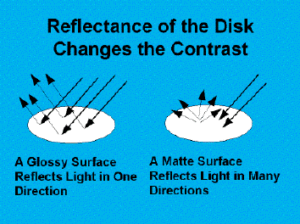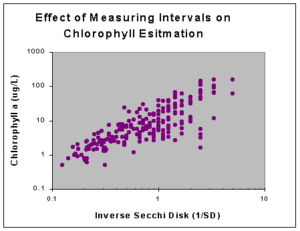Portions of the text below have been excerpted from the following NALMS publications:
Carlson, R.E. 1995. The Secchi disk and the volunteer monitor. LakeLine. 15(1): 28-29, 35-37.
Carlson, R.E. and J. Simpson. 1996. A Coordinator’s Guide to Volunteer Lake Monitoring Methods. North American Lake Management Society. 96 pp.
Carlson, R.E. 1997. The Secchi disk in black and white. LakeLine. 17: 14-15, 58-59.
The Secchi disk is and should be the cornerstone of volunteer lake monitoring programs. It is inexpensive and provides useful data. However, it does have a number of technical problems that need to be addressed. Many of the problems can be minimized by standardizing the equipment and carefully training the volunteers.
Disk Construction
It is amazing the number of objects that have been used as disks, apparently with success. A white Frisbee has been used in an emergency. Jones and Bachmann (1978) used plastic dinner plates in Iowa. The dinner plates gave the same reading as a standard disk and were far less expensive. A painted 15 cm (6 in) margarine container lid (McCauley, 1990) and a large coffee can lid (Schelske, Personal communication) have also been used as disks. The volunteer program in Minnesota uses an all-white disk with two opposing notches, which provide a convenient spot to wind the rope.
Disk Size
The size of the disk has also varied. Marine disks are 40 or 50 cm (16 to 20 in) in diameter, but, in lakes the standard has become 20 cm (8 in). According to theory, a larger disk should be seen deeper than a smaller one, but, there are studies that have found no difference between large and small disks. Some studies found that, in very clear waters, the disk disappeared, not because of loss of contrast, but because the disk became too small to see. In these instances, scientists have used disks with diameters of up to 1.2 m (3.9 ft). At the opposite end of the size spectrum, disks as small as 2.5 to 5 cm (1 to 2 in) have been used in small puddles (Richard Hill, Personal communication).
Reflectance

Figure 1. Disks should be designed to have a matte finish rather than a glossy finish, which may act like a mirror.
It should be possible to standardize the reflectance of the disk. Since the observer is viewing reflected light, theory suggests that the more light reflected back up to the observer, the more intense the contrast between the disk and its background. The greater the contrast, the deeper the disk will be visible. If reflectance were the only consideration, then why not use a mirror for a disk? The problem with a mirror is that it reflects all the light at an angle equal that of the light striking the disk; therefore its amount of light reflected directly upward should be highly dependent on the angle of the sun. The best disk would reflect light equally in all directions, whatever the angle of the sun. A glossy finish may accentuate problems related to the angle of the sun and of the time of day, but this has not been investigated. A matte disk should eliminate or lessen these effects. The same paints should be used as more disks are made, so that the reflectance remains constant. Volunteers should also be reminded to keep the disk clean and free of scratches.
Measuring Line
A number of programs use a marked line. Volunteers simply read the Secchi depth based on the markings on the line. The advantage of this method is simplicity, but there are several disadvantages to marking the line.
Shrinkage could introduce a significant error in the measurement. A number of programs report shrinkage in the line.

Figure 2. The figure to the right uses the Florida data of Canfield and Hodgson (1983) to illustrate the problem of using larger intervals on the measuring line. In this case, the Secchi readings were rounded off to 10 cm (3.9 inches) A plot of the inverse Secchi depth versus chlorophyll reveal ever-increasing gaps with no data as the Secchi depth falls below 1 meter (1/SD > 1.0). This effect could have been minimized if a smaller measurement interval had been used.
The measuring marks used (1/4 to 1 foot in some programs) does not allow for the accuracy that is possible with the Secchi depth. Measuring Secchi depth at intervals of even 1/4 foot can introduce significant errors in low transparency waters (Fig. 2).
The possible psychological effect of having markers may be a third, as yet undocumented, error. If the volunteer has a priori knowledge about the Secchi depth based on values obtained during their last visit or if they take replicate samples, this knowledge, combined with the visual clues of depth given by the markings, could bias their readings. Wilson (Personal communication) also suggests that marking lines is very expensive.
We recommend the use of an unmarked line and the use of a yardstick or meter stick to measure depth. This technique requires the additional equipment of a measuring device and added time of measurement. However, the advantages of not having to worry about shrinkage, the reduced cost, and the elimination of statistical or possible psychological errors far outweigh the additional equipment and effort. The alternative would be a highly accurate marked line, such as a nylon measuring tape, together with a viewscope. The tape gives the reading the precision possible and the viewscope keeps the observer from seeing the results until after the measurement has been made.
The Observer
The human factor must also be considered. The observer must accurately see and record the Secchi depth. The human eye does not respond exactly to the spectrum of light being reflected by the disk, and, therefore, the disk reading would be different in waters of different color (Preisendorfer 1986). To correct for this,the observer should view the disk through a Wratten #61 green filter to standardize the color of light entering the eye (Williams 1970). However, apparently no one has adopted standardized filter glasses.
What is the “Proper” Design
In the opinion of Secchi Dip-In founder, Robert Carlson, the disk design should be as follows:
- A flat 20 cm disk with alternating black and white quadrants.
- The surface should have a matte (flat) finish.
- The lowering line should be unmarked or, if a viewscope is used, a fiberglass measuring tape should be used for the line.
- In very clear waters a larger, 40 cm disk, again with black and white quadrants, should be used.
This disk should, according to theory, work best under all possible light climates, have the least interference with sun angle, and minimize the errors involved with measuring the depth. However, these recommendations are only guidelines for new programs. If a program is already using a disk of a different design they should be very cautious of changing designs, especially if the change would invalidate comparisons with past years’ data. Such changes might include the size, reflectivity, or color of the disk. Changing to a viewscope would also change the nature of the data being gathered. If time trend analysis is at all important to the program, be very cautious about making changes.
It is also important to consider the possible effects of ordering new disks. Will they be the same as the old models? If you are making your own, are you using the same type of paint, thus insuring the same reflectance? As the disks get older, are you insuring that the surfaces of the disk are still clean? We have seen too many disks that are scratched, chipped, or rusted to deny that care of the disk surface is not considered to be that important. Perhaps someone should invent a disk holder that will protect the disk when it is not being used.
Some Useful References
Canfield, D.E. Jr. and L.M. Hodgson. 1983. Prediction of Secchi disc depths in Florida Lakes: impact of algal biomass and organic color. Hydrobiologia. 99: 51-60.
Davies-Colley, R.J. 1988. Measuring water clarity with a black disk. Limnol. and Oceanogr. 33: 616-623.
Davies-Colley, R.J, W.N. Vant, and D.G. Smith. 1993. Colour and Clarity of Natural Waters. Ellis Horwood.
Hutchinson, G.E. 1957. A Treatise on Limnology. Vol. 1. Geography, Physics, and Chemistry. John Wiley & Sons.
Preisendorfer, R.W. 1986. Eyeball optic of natural waters: Secchi disk science. NOAA Tech. Memo. ERL PMEL 67. 90 p. NTIS PB86 224060/AS.
Tyler, F.E. 1968. The Secchi disc. Limnol. Oceanogr. 13: 1-6.
Williams, J. 1970. Optical Properties of the Sea. U.S. Naval Institute.

